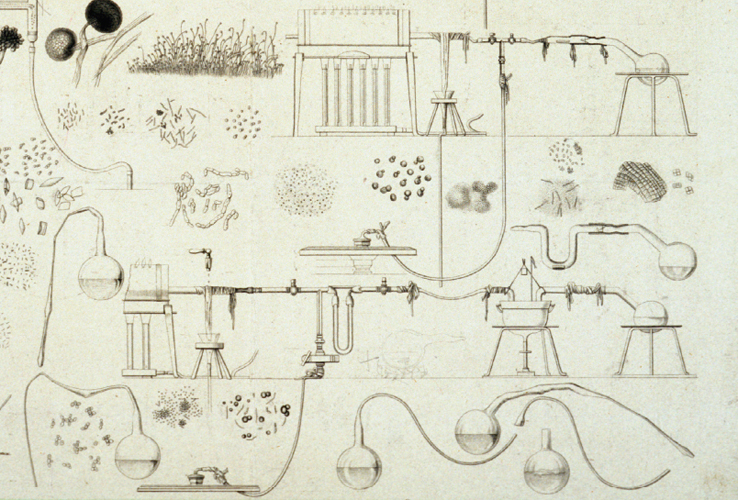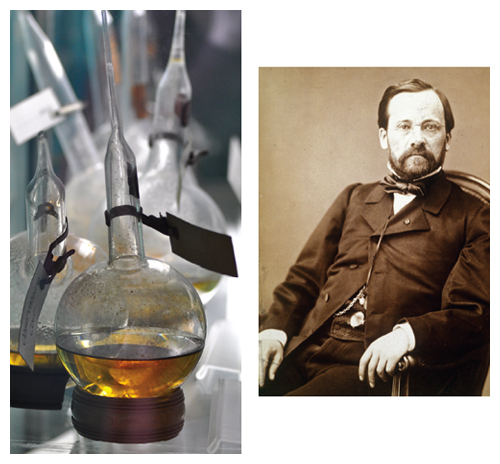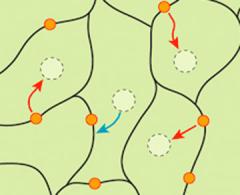
This Article From Issue
July-August 2010
Volume 98, Number 4
Page 286
DOI: 10.1511/2010.85.286
The year 1859 ended with two big scientific bangs. On Thursday, November 24th, the first edition of On the Origin of Species by Means of Natural Selection was published by John Murray in London. Fifteen days later and across the English Channel, on the evening of Monday, December 9th, Louis Pasteur presented to the Chemical Society of Paris his first experimental results attacking the doctrines of spontaneous generation. Two such monumental discoveries would have made it a good month in any branch of science. Although it was not obvious at the time, Darwin and Pasteur were laying out the foundations of contemporary biology.

Institut Pasteur
The story we often hear about Pasteur falls into the “we once were blind, but now we see” narrative. In this version, superstition and ignorance reigned before Pasteur; light and reason ruled thereafter. Until Pasteur, we are taught, we did not understand that only life begets life. After his observations and experiments (so the story goes), we did. The real events, however, are far more interesting—and complex. Pasteur waded into a controversy that had been ongoing since the time of the ancient Greeks, and had become an enormously active area of investigation and speculation from the 18th century onward. Natural scientists and philosophers sought to understand the relationships between chemistry and biology. The emergence of microscopy—and with it the realization that living beings were everywhere, even beyond the reach of the human eye—made the question more urgent: Where was all of this life springing from?
Vegetative Forces
Scientists, as well as vintners, brewers and butchers, well knew that virtually all food or drink left unattended would soon teem with life. In retrospect, the observation that a nutrient broth (like bouillon) left unrefrigerated would quickly be swimming with organisms seems to us self-evident. The prevailing notion, however, that this outcome depended on some feature of the air—some principle or property that gave rise to life in a previously lifeless fluid—seems almost incomprehensible to us today. But at the beginning of the 19th century, the vertiginous rise of chemistry had introduced beguiling notions of crystallization, explosion and spontaneous reaction into the scientific vocabulary. It did not seem that farfetched to imagine that organic molecules could similarly organize, crystallize and react to give rise to living organisms.
Yet several experiments, well known to working scientists in Pasteur’s time, had already been performed in an effort to demystify what appeared to be the spontaneous emergence of life. As early as 1668, Francesco Redi demonstrated that the flies that appeared in decaying meat necessarily came from the eggs laid by earlier flies that had had access to the meat. Definitive as that demonstration appeared, however, its results were contradicted by many other experiments. Most notable were those of John Needham, the 18th-century cleric and scientist whose experiments and theories supported spontaneous generation. He observed that blighted wheat seeds gave rise to “tiny eels,” and that these eels appeared viviparous and hence could not be the result of eggs being laid on the seeds. In collaboration with an eminent naturalist, Georges-Louis Leclerc, Comte de Buffon, he also boiled mutton broth in a sealed flask, only to find that the broth still became cloudy with organisms. Needham went on to propose a “universal vegetative force,” which, in an “exalted state,” could account for the emergence of life in broths, flour and water mixtures, and blighted seeds.
Needham’s ideas did not receive an enthusiastic response. No less caustic and influential a skeptic than Voltaire dissected Needham with his wit, and no less august a scientist than Lazzaro Spallanzani spent a decade contradicting Needham’s experiments. Experimental and philosophical objections to the Needham-Buffon worldview accumulated. The experimentalists soon showed that the extent to which broths were boiled mattered. They suggested that Needham and Buffon had simply not managed to get rid of preexisting life in the flasks—and hence had not really demonstrated spontaneous generation. But criticism also came from those, Voltaire included, who feared that theories of spontaneous generation foreshadowed an ever-smaller role for God as the source of life. If, after all, life emerged as the result of some inherent properties of matter, what role did theistic explanation have to play?
The Prize
By the mid-19th century, the debate around spontaneous generation had moved to a more empirical and material plane. Increasingly sophisticated experiments involving the boiling of nutritive broths in sealed flasks were now underway. In part, these more advanced experiments addressed the objections raised by the spontaneists that the air in the flask had been corrupted by virtue of the heat generated by boiling and had thus lost its vegetative force. New experimental designs allowed new air into the sealed flasks after heating. Furthermore, this new air could be filtered, heated, or passed through sulfuric acid or charcoal prior to its introduction into the flasks, thus ridding it of living contaminants. These experiments pointed to the conclusion that any combination of treatments that would destroy germs in the broth (boiling) and in the incoming air (filtering) would result in a lifeless solution.
Still, old theories die hard. Inconsistencies in the experimental outcomes and confusion in the interpretations lingered. In frustration, the French Academy of Sciences threw down the gauntlet, offering the Alhumbert prize to anyone who “would, by virtue of well-conceived experiments, bring about a new day on questions of so-called spontaneous generation.” The prize committee was chaired by Geoffroy St.-Hilaire, an eminent French anatomist who would soon, interestingly, become a ferocious critic of Darwin.

But as far as the controversy with spontaneous generation was concerned, Pasteur was a reluctant theorist. He entered the fray primarily because he thought it might help him strengthen his conclusions about the nature of fermentation. His friends warned him to tread carefully and to set a time limit to his involvement in what appeared to be a potentially unsolvable controversy. But Pasteur could not resist; he was a superb experimentalist and a committed empiricist, and he developed a series of ingenious swan-necked flasks that proved crucial to his demonstrations. This part of the story, along with the flasks themselves, has by now achieved mythical status in biology.
What is less acknowledged, however, is Pasteur’s ecological thinking. He understood that any argument that invoked existing organisms to account for the colonization of sterilized broth depended on the demonstration that organisms existed in the air, and in sufficient numbers to explain the results. Intellectually subtle, Pasteur understood that the concentration of bacteria (or spores, cysts or any other airborne colonist) would likely vary from environment to environment. He undertook experiments to prove just that point. In elegant 19th-century prose, he describes how air drawn in from “a quiet street in Paris, at a height of 3 to 4 meters” (the Rue d’Ulm, as it turns out) after several beautiful summer days, contained “thousands of organized corpuscles.” But, he argued:
… this result will vary depending on the state of the atmosphere, if we are working before or after a rain, in quiet or agitated atmospheric conditions, during the day or at night, and near or far from the ground…. Imagine the thousand and one causes that might increase or reduce the number of solid particles that we have all seen floating in a beam of light that penetrates a dark room … we must [thus] expect differences in our experimental outcomes.
Pasteur would go on to repeat his experiments drawing air into sterilized broths at different times, in varying weather, at varying altitudes, in cities and in towns, in the countryside and on glaciers. And every time, his experiments demonstrated consistent results, which he would summarize in 1862, upon receiving the Alhumbert prize: “Spontaneous generation is a chimera.”
The First Case
Pasteur, of course, was right, but with one major exception. If we think of contemporary organisms in the present, life begets life, and like begets like. But if we look into the past, we quickly realize that there must have been at least one time when Pasteur’s dictum did not hold. Some 3.8 to 4 billion years ago, life on Earth emerged from nonlife. Astonishingly early in the history of this planet, its abiotic chemistry assembled into the rudiments of living systems. Those early systems, capable of organizing their chemical reactions, defining an inside and an outside, storing information, encoding their own history and, crucially, evolving, would irreversibly alter Earth’s surface and history.
The origin of life is a crucial question for modern biology. It is also a material question to be addressed with material explanations. I am certain that biology, together with chemistry and information theory, will unravel the question of how life may have originated. As scientists, however, we are not equipped to explain what the origin of life “means” or what its “purpose” is. Instead we are taking on the challenge of understanding how organized chemistry emerges from spontaneous chemistry, and how transient organization becomes transmitted information—in short, how nonlife becomes life.
We are making progress, and have over the past decade come to understand that early in the history of life (unlike the current state of affairs), function and information may have been deeply and sloppily intertwined. But to make things more complicated, the line between the living and the nonliving is not as sharp as we once thought. Gone are the days when we spoke of élan vital or of exalted vegetative forces, but we are not quite sure what to claim in their place as the exclusive hallmarks of living systems.
The rise of a new field in biology, synthetic biology, may shed light on these issues. The goal of this emerging subfield is to show that a working organism, one that has never before existed, can be assembled in the lab. The genomes of these new creatures are under construction—they are being assembled in numerous labs by stitching together selected genes from a variety of existing organisms. The comparisons to Dr. Frankenstein’s creation are tempting, but this is an altogether less sinister undertaking. At its core, the justification for this effort is utterly pragmatic: to custom-design organisms (bacteria, primarily) that exhibit features we deem desirable. We can easily imagine the benefits of a bacterium that readily transforms cellulose into ethanol, or one that takes toxic chemicals and breaks them down into less harmful products. And we now believe we can custom-build the organisms we need. Much like that fateful winter in 1859, a new discovery in synthetic biology might soon alter the path of scientific research and discovery in many disciplines for many years to come.
These efforts to assemble a completely new organism in the lab are, in unexpected ways, tests both of Pasteur’s and of Darwin’s rules. If we succeed in building a new organism from the genes of existing organisms—or from modified versions of those genes—we will in effect be building life from life, and in so doing, remaining faithful to Pasteur’s tenets. We are betting, of course, that genes that work well in the organism in which they evolved will also function in a completely different context—and function in the ways we want them to. This conception of genes as self-contained and context-independent units of information remains to be fully tested.
But let me be clear: There are no metaphysics here. I am not arguing that genomes are endowed with some ineffable and untestable quality. Instead, the question we are asking is whether real genomes are more than the sum of their gene parts. Genes in existing organisms, after all, have traveled together in a genome for millions of generations. We will soon find out whether the evolution of genomes involves a subtle, or perhaps a not-so-subtle, ongoing conversation among the genes that compose a genome. Take the genes entirely out of context, pair them with other genes evolved in wholly different settings, and something important may be lost.
Evolving to Evolve
Of course, the entire biotechnology revolution provides a partial answer to the question raised above—yes, certain genes can function independently of their genome. I can clone the gene for human growth hormone into a bacterium and that bacterium will still produce working human growth hormone for me. However, taking one gene out of context and cloning it into an existing genome is different from knitting genes from different organisms together and expecting them to produce an organism that works.
I suspect that the ambitious agenda of synthetic biology will lead to powerful insights about the nature and origin of living systems. I am convinced that we will learn a great deal about the modularity of genes, and about the interactions among genes that make life possible. I predict that these synthetic organisms may actually be capable of surviving, and perhaps even of reproducing under the tightly controlled conditions of the laboratory. But what remains to be seen is whether these living forms we create in the lab will be capable of evolution. If we are to call them truly alive, our synthetic organisms will have to exhibit the capacity to adapt in response to changing conditions.
Existing organisms have in effect evolved to evolve, balancing their mutation rates to the vagaries of the environment and the costs and benefits of the accurate copying of genetic information. Synthetic organisms, if they reproduce and vary, will indeed necessarily evolve. But we may well find that their patchwork genomes will not yet have developed the subtle diplomacy that allows them to keep up with a changing world. Their lives on this Earth will thus be decidedly short by evolutionary standards. Yet much like copernicium or ununquadium, newcomer elements in the periodic table whose half-lives are measured in seconds (or even in milliseconds), the scientific value of synthetic organisms will not depend on their longevity. It will depend on their having lived at all.

American Scientist Comments and Discussion
To discuss our articles or comment on them, please share them and tag American Scientist on social media platforms. Here are links to our profiles on Twitter, Facebook, and LinkedIn.
If we re-share your post, we will moderate comments/discussion following our comments policy.